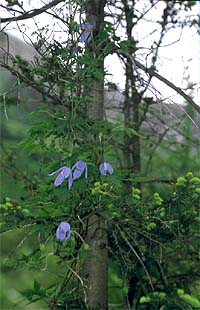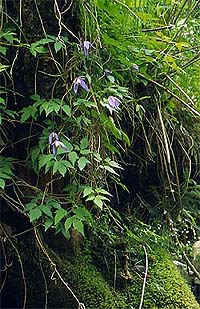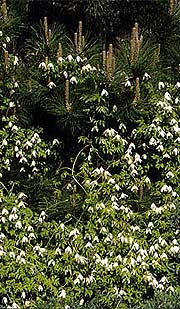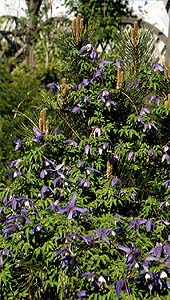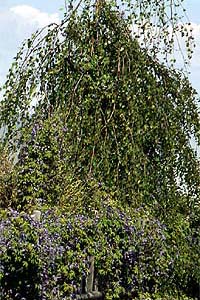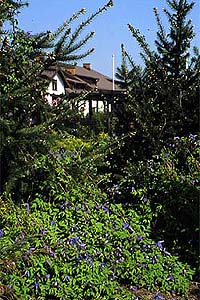ALPINE CLEMATIS – CLEMATIS ALPINA
In April, particular attention should be drawn to Clematis alpina (Alpine Clematis) whose flamboyant blossoming announces the coming of the Spring. The species belongs to Ranunculaceae (the Buttercup Family).
Szczepan Marczyński
Alpine Clematis is a close relative to anemone, pasque-flower and hepatica, the relatedness can be easily noticed if you examine closely its flowers or leaves. Not everyone knows that it’s a mountain species native to the Alps and the Tatra Mountains, where it can be found climbing into trees and scrambling over large rocks in semi-shaded positions between the zones of upper subalpine forest and mugo pine. It is a species-conserved region so you can’t pick the flowers, break the stems or dig it out of the ground. It grows up to a height of 2-2,5 m, attaching itself to supports by means of curling petioles, in a similar way to other clematis. In the cool mountain climate.
- Clematis alpina in the Tatra Mountains. Jaworzynka Valley – photo Sz. Marczyński
- Clematis alpina in the Tatra Mountains. Strążyska Valley – photo Sz. Marczyński
- Clematis sibirica Atragene Group – photo Sz. Marczyński
Alpine clematis doesn’t blossom until June. Blue bell-shaped nodding flowers, with four petals and a central tuft of white staminodes (transformed stamens) half of the length of the petals, are borne on slender stalks on previous year’s wood. Silky seedheads that follow the flowers often stay on the vine for several months and give a charming display of a billowing cloud surrounding the plant.
Its white-flowered variety – Clematis alpina var. sibirica (Siberian Clematis) grows in the mountains of Scandinavia and Siberia.
Clematis alpina and its Siberian variety have long been domesticated on account of its ornamental value, they are widely propagated and cultivated in nurseries, and used in gardens. In the process of selection and cross-breeding with similar species e.g.: Clematis macropetala, Clematis ochotensis or Clematis faurieri a number of cultivars in a variety of colours have been derived: blue (‘Frances Rivis’, ‘Frankie’, ‘Pamela Jackman’, ‘Blue Bird’, ‘Cecile’, ‘Lagoon’, ‘Maidwell Hall’ ), pink (‘Pink Flamingo’, ‘Willy’, ‘Ballet Skirt’, ‘Jacqueline du Pré’, ‘Markham’s Pink’, ‘Pointy’, ‘Rosy O’Grady’), mauve-pink (‘Betina’, ‘Constance’, ‘Ruby’), purple (‘Brunette’, ‘Jan Lindmark’, ‘Purple Spider’, var. ochotensis) and white (var. sibirica, ‘Albina Plena’, ‘Riga’, ‘White Swan’) which belong to Atragene Group. All cultivars are very hardy, immune to diseases and quite undemanding. They thrive best in moderately moist (fresh) neutral or slightly alkaline soils, in the north facing or other cool locations. They prefer dappled sun, but will also grow in a sunny site. These vines will not tolerate excessive saltiness therefore you should fertilize them delicately only if the soil is poor. They are suitable for growing over all kinds of garden supports (trellises, gates, pergolas, low walls etc.), and can be grown over fences (wire meshes, wooden and others) replacing a hedge, but they are really superb when grown over natural supports such as evergreen or deciduous shrubs, in the way they grow in their natural environment.
- Clematis Atragene Group ‘Frances Rivis’ – photo Sz. Marczyński
- Clematis Atragene Group ‘Pamela Jackman’ – photo Sz. Marczyński
- Clematis Atragene Group ‘Pamela Jackman’ – photo Sz. Marczyński
These clematis are not rampant growers so there’s no danger that they will harm their hosts, and their rambling stems will add charm and beauty to any garden. When left to scramble over the ground they may work as a groundcover. Owing to the fact that alpine clematis and its cultivars blossom on the previous year’s wood there is no need to prune them. In the early spring you may cut back the withered and broken stems. In case when the pant has spread out excessively and starts to hinder other plants growth it may be advisable to prune it back. This is best done just after the spring flowers have faded.

